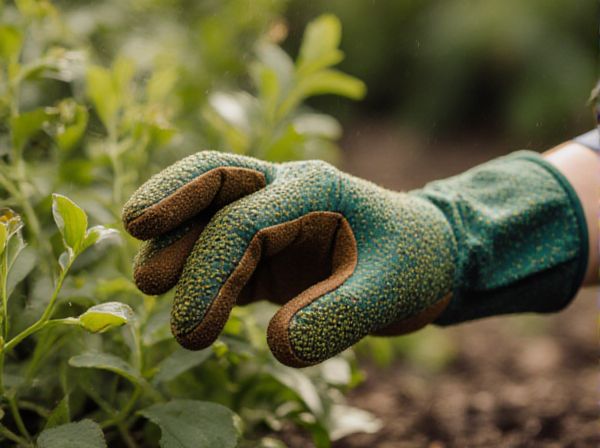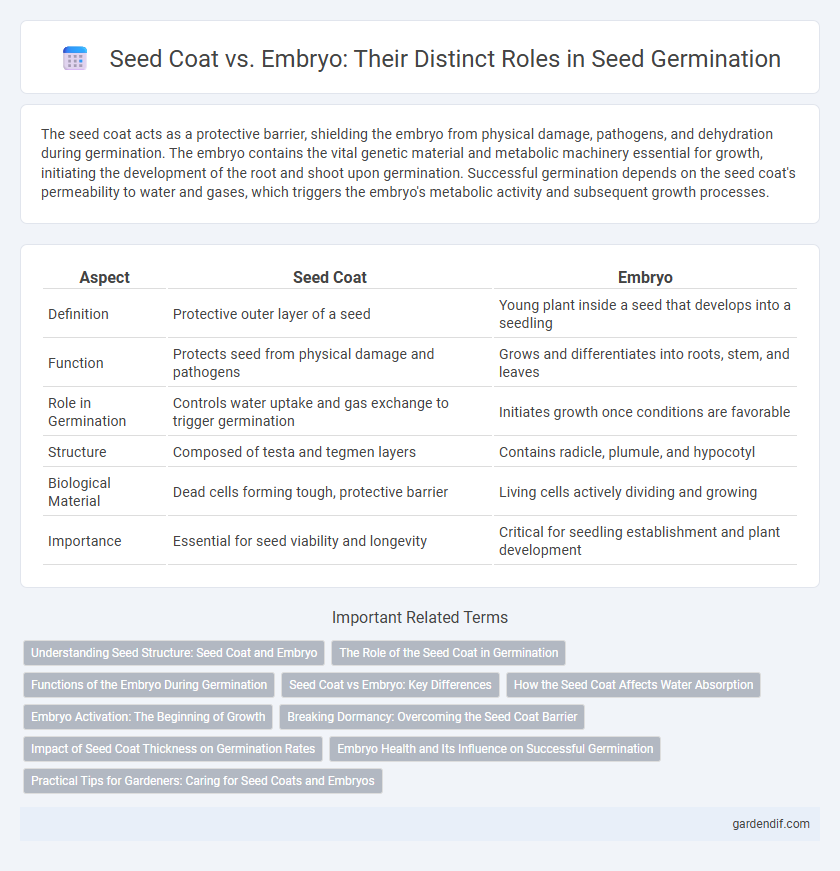
Seed Coat vs Embryo Illustration
The seed coat acts as a protective barrier, shielding the embryo from physical damage, pathogens, and dehydration during germination. The embryo contains the vital genetic material and metabolic machinery essential for growth, initiating the development of the root and shoot upon germination. Successful germination depends on the seed coat's permeability to water and gases, which triggers the embryo's metabolic activity and subsequent growth processes.
Table of Comparison
| Aspect | Seed Coat | Embryo |
|---|---|---|
| Definition | Protective outer layer of a seed | Young plant inside a seed that develops into a seedling |
| Function | Protects seed from physical damage and pathogens | Grows and differentiates into roots, stem, and leaves |
| Role in Germination | Controls water uptake and gas exchange to trigger germination | Initiates growth once conditions are favorable |
| Structure | Composed of testa and tegmen layers | Contains radicle, plumule, and hypocotyl |
| Biological Material | Dead cells forming tough, protective barrier | Living cells actively dividing and growing |
| Importance | Essential for seed viability and longevity | Critical for seedling establishment and plant development |
Understanding Seed Structure: Seed Coat and Embryo
The seed coat acts as a protective barrier, shielding the embryo from physical damage, pathogens, and dehydration during dormancy. The embryo contains the essential embryonic root (radicle), shoot (plumule), and cotyledons, which provide initial nutrients for seedling development. Understanding the distinct roles of the seed coat and embryo is crucial for optimizing germination conditions and improving seedling vigor.
The Role of the Seed Coat in Germination
The seed coat serves as a protective barrier that regulates water uptake and gas exchange essential for germination. Its permeability influences the timing of embryo activation by controlling environmental exposure and preventing damage from pathogens or physical stress. By modulating moisture absorption, the seed coat ensures optimal conditions for the embryo's growth and successful seedling emergence.
Functions of the Embryo During Germination
The embryo is the essential part of the seed responsible for developing into a new plant during germination, containing the embryonic root (radicle), shoot (plumule), and cotyledons that supply initial nutrients. Unlike the seed coat, which protects the seed from physical damage and dehydration, the embryo actively undertakes cell division, elongation, and differentiation to form the seedling's root and shoot systems. Its metabolic activities trigger the breakdown of stored food in the cotyledons or endosperm, fueling growth and ensuring successful establishment of the emerging plant.
Seed Coat vs Embryo: Key Differences
The seed coat is the protective outer layer that shields the embryo from physical damage and prevents water loss, while the embryo is the living part of the seed that develops into a new plant. The seed coat is composed primarily of dead cells and acts as a barrier to pathogens, whereas the embryo contains cells capable of growth and differentiation. During germination, the seed coat must first soften or break to allow the embryo to absorb water and nutrients necessary for its development.
How the Seed Coat Affects Water Absorption
The seed coat significantly influences water absorption by acting as a protective barrier that regulates moisture entry into the embryo. Its permeability varies among species, affecting the imbibition rate crucial for activating metabolic processes during germination. Seeds with thick or hard coats often require scarification to enhance water uptake and ensure successful embryo development.
Embryo Activation: The Beginning of Growth
Embryo activation marks the essential beginning of seed germination, where metabolic processes awaken from dormancy within the embryo, initiating growth. The seed coat protects this vital embryo, regulating water absorption and gas exchange crucial for triggering enzymatic activity that spurs cell division and elongation. Optimal moisture, temperature, and oxygen availability enable the embryo to transition from a dormant state to active development, driving root and shoot emergence.
Breaking Dormancy: Overcoming the Seed Coat Barrier
Breaking dormancy in seeds often hinges on overcoming the physical barrier of the seed coat, which restricts water and oxygen uptake essential for embryo activation. Mechanical scarification, acid treatment, or thermal exposure weaken or rupture the seed coat, enabling the embryo to commence metabolic processes critical for germination. The embryo's viability and readiness depend on successful seed coat disruption, which triggers cellular growth and development necessary for seedling emergence.
Impact of Seed Coat Thickness on Germination Rates
Seed coat thickness significantly influences germination rates by controlling water uptake and gas exchange essential for embryo development. Thick seed coats can delay or inhibit germination by preventing moisture penetration, while thinner coats generally facilitate faster embryo activation. Variations in seed coat permeability are critical factors determining the timing and success of seed germination across plant species.
Embryo Health and Its Influence on Successful Germination
The embryo's health is crucial for successful germination as it contains the vital genetic material and initial growth structures necessary for seedling development. While the seed coat provides protection against physical damage and pathogens, it does not influence the biochemical processes within the embryo that determine viability. Optimal embryo health ensures rapid cell division and nutrient mobilization, directly impacting germination rates and seedling vigor.
Practical Tips for Gardeners: Caring for Seed Coats and Embryos
Maintaining seed coat integrity is crucial for protecting the embryo during germination and ensuring successful sprouting. Gardeners should scarify tough seed coats by gently nicking or soaking them in warm water to facilitate water absorption and embryo activation. Properly handling seeds by avoiding damage to the delicate embryos increases germination rates and supports healthy seedling development.
Seed Coat vs Embryo Infographic

 gardendif.com
gardendif.com